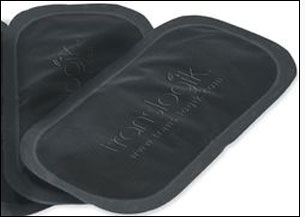Since Malaysian logistics firm Lee Ting San (LTS) Group began trialing an RFID-based tire-management system a year ago on some of its 400 trucks, the company has found that tagged tires are better maintained and have fewer blowouts than those without RFID tags, according to Ahilan Thiyagarajah, the managing director of Auto RFID Solutions, which installed the system. The tire-management solution, known as e-Tyre and provided by Malaysian RFID company FEC International, consists of an EPC Gen 2 passive RFID patch tag, a tire probe for determining a tire’s tread depth and air pressure (the patch tags and tire probes are manufactured by Translogik), a handheld RFID reader and e-Tyre software.
The company began testing the technology in January 2010, during a trial involving three 14-wheeler trucks, for a total of 42 tires. LTS’ staff permanently attached an RFID patch tag (an RFID inlay encased in protective layer of rubber) to the exterior of each tire, on the sidewall facing the center of the vehicle. Auto RFID Solutions provided training on how to attach the tags via an adhesive. The unique ID number encoded to each tag is then read using an RFID-enabled AT870 RFID handheld computer made by All That Identification (ATID), and that ID is linked, in the e-Tyre software installed on LTS’ back-end system, with tire information input into the handheld reader, such as brand and model numbers. Once the tire is installed on a truck, workers use the handheld to read the tire’s tag, then input such information as the truck’s vehicle identification number (VIN), license plate number, make, model and depot name, as well as its odometer reading, to link the vehicle to that particular tire.

The pilot began small, Ahilan says, because to the Malaysian logistics industry, “RFID was new, and we needed some time to educate the advantages of RFID to truck owners.”
According to Ahilan, Lee Ting San Group is the largest company in Malaysia to provide general logistics, container haulage and warehousing services, with several locations in Penang and northern Malaysia. Like most logistics firms, LTS manually tracks its truck tire maintenance, with inspectors testing pressure and tread, manually writing down the results, and carrying out maintenance when necessary, again recording the details on paper. Companies with large fleets often find it difficult to manage details regarding the condition of all of their tires. As a result, tires might not be properly maintained, thereby leading to safety issues, higher fuel costs (if air pressure is low, for example) or a short tire life.
The RFID system has solved these problems, Ahilan says, by providing the company with alerts whenever tires are due for maintenance, as well as an electronic record of each inspection and its results. LTS had hoped to eliminate the risk of errors during data collection, he explains—such as the incorrect recording of a tire’s ID number, or the omission of important details—and to increase visibility into whether the firm’s tires were being properly maintained and inflated. The company also hoped to reduce the number of blowouts resulting from improperly inflated tires.
When tire inspections are planned, the e-Tyre data is loaded onto the handheld reader. Staff inspectors go to each truck, and first update mileage and other vehicle data on the handheld terminal, then read each tire’s RFID tag. After reading the tag, the inspector uses the tire probe to measure the tire’s tread and pressure, and that information is transmitted to the handheld reader via a Bluetooth connection. The operator can then view the results of each measurement on the handheld’s screen as the data is received. The reader is then placed in a cradle attached to a PC, and all reader data (tag IDs linked to inspection data) is stored with the tire and vehicle details.
The software then provides reports and analyses, including when tires need to be maintained or discarded, as well as the frequency of retreading or other maintenance history, to help LTS measure its tires’ performance. The software can also issue an order to employees for maintenance or repair, such as retreading, rotating or discarding tires.
The RFID patch tag, which measures 120 millimeters by 35 millimeters by 5 millimeters (4.7 inches by 1.4 inches by 0.2 inch), has 96 bits of memory for the Electronic Product Code (EPC) number, and an additional 512 bits of user memory; however, LTS is using only the encoded RFID number on the tag. To date, Ahilan says, the greatest benefit that the company has seen from the system has been in ensuring that tire pressure is checked regularly, and that tires are inflated properly when needed. Prior to the system’s installation, he explains, about one tire blew out every two months.
“With the introduction of this system,” Ahilan states, “we have not seen any tire-burst problem occur.” Ultimately, he adds, the solution has improved the road safety of the LTS fleet, and has enabled the company to provide safer, more reliable service to its end customers. What’s more, the firm finds that tires last longer, since they are inflated to the correct pressure on a regular basis. Lee Ting San Group plans to begin expanding the system, Ahilan says—initially, with approximately 10 more trucks, though the timing of such an expansion has yet to be determined.

